
Feature Article
How to Keep Food Safe in Case of a Power Cut at Home?
Prolonged power cut is uncommon in Hong Kong nowadays. However, sudden interruption of electricity supply may still occur due to unforeseeable factors such as adverse weather and equipment failure. Power disruptions can last for minutes to hours, during which food will spoil rapidly without refrigeration. Power cut can be troublesome, especially when you have a lot of perishable food items in your refrigerator and freezer compartment. Nonetheless, there is no need to panic. The following tips can help you keep food safe while waiting for resumption of power supply.
Keep the Refrigerator and Freezer Shut During Power Cut
When there is no electricity, the refrigerator and the freezer can no longer be used for storing food at safe temperatures. Food must be kept at 4°C or less in the refrigerator and at -18°C or lower in the freezer compartment to hinder the growth of harmful bacteria and other microorganisms that can cause foodborne illnesses. In case of a power cut, it is best not to open the refrigerator and the freezer compartment. This helps maintain proper storage temperatures as long as possible and prevent bacteria from growing rapidly in the temperature danger zone of 4°C to 60°C.
Overseas food authorities such as the US Food and Drug Administration and the Food Standards Australia New Zealand generally accept that if the doors of a refrigerator are kept closed, food will stay safe when stored in the refrigerator compartment for 2 to 4 hours, in a full freezer compartment for 48 hours or in a half-full freezer compartment for 24 hours. Therefore, knowing when the power cut starts is useful in tracking how long the refrigerator and the freezer compartment have been without power. This will help you determine which food items are still safe for consumption.
Follow the “4-Hour/2-Hour Rule” after Resumption of Power
When power is restored, you should check the temperature of perishable food items to find out how long they may have been out of the safe temperature range. For potentially hazardous foods such as meat, seafood, eggs, milk, dairy products, cut fruits and cooked dishes, keep them refrigerated or use them immediately if they have been stored between 4°C and 60°C for less than 2 hours, use them immediately if they have been within this temperature range for longer than 2 hours but less than 4 hours, or toss them away if the duration is more than 4 hours.
Do not taste food to see if it is still good as the food may taste or smell just fine. If you are not sure about the safety of easily-spoiled food, simply discard them. Non-perishable food that can be stored at room temperature and is kept in the refrigerator compartment or the freezer compartment may not need to be thrown away in the event of a power cut. High-acid foods (e.g. mustard, ketchup, jams, pickles), certain processed foods (e.g. peanut butter, butter, bread) and most dried foods are typically better preserved than other foods in blackouts.
Prepare for Emergency in Time of Peace
During non-crisis times, we should make sure that the refrigerator compartment is at 4°C or below and the freezer compartment at ‑18°C or colder. It is advisable to place appliance thermometers in both compartments. In addition, always keep some ice cubes and frozen gel packs in the freezer compartment. They can keep the compartment full to help maintain the temperature and keep food cold should they be transferred to other places (e.g. friends’ or relatives’ refrigerators).
It is a waste of money to throw away food, but the risk of contracting foodborne illnesses is even more costly, as it can cause severe health consequences or even death. If any food is suspected to be deteriorated, it is not worth the risk eating it, especially if young children, the elderly and people with compromised immune systems are involved. The best policy is to exercise caution and discard the food whenever in doubt. You should also adhere to the Five Keys to Food Safety during emergencies to protect yourself and the people around you from foodborne diseases.
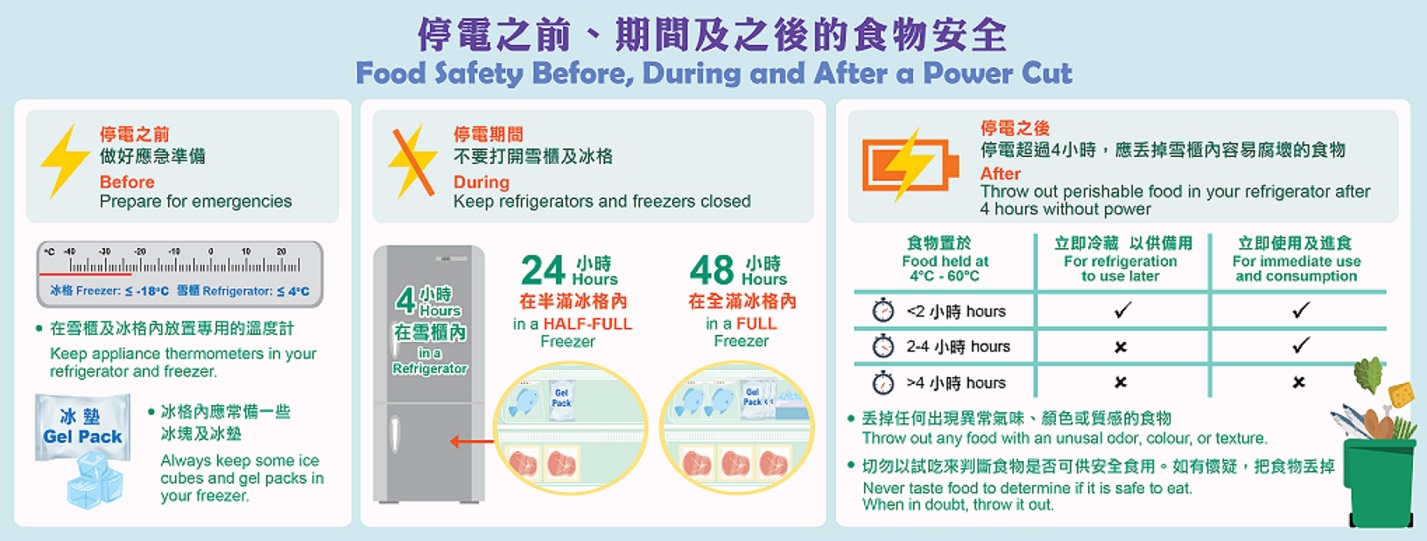
Figure: Food safety before, during and after a power cut
Mascot ON in Lesson
Good Hygiene Practices in Food Premises
Food premises of poor hygiene will not only have low online ratings and a bad reputation, they are also likely linked to foodborne disease outbreaks, thus posing hazards to consumers and giving rise to litigation. In this article, we will talk about Good Hygiene Practices (GHPs) and discuss how GHPs can help food business operators (FBOs) to safeguard food safety and consumers’ health.
Five Keys to Food Safety
Contaminated or spoiled food can cause foodborne diseases. Over the past few years, bacteria are the main causative agents of food poisoning outbreaks relating to local food premises and food businesses as a result of inadequate cooking, cross-contamination and improper storage temperatures of food. To prevent foodborne illnesses, FBOs need to handle food in ways that can ensure good food hygiene. This can be achieved by following the Five Keys to Food Safety, namely (1) “Choose” (choose safe raw materials), (2) “Clean” (keep hands and utensils clean), (3) “Separate” (separate raw and cooked food), (4) “Cook” (cook thoroughly), and (5) “Safe temperature” (keep food at safe temperatures). The Five Keys are the basic guiding principles in ensuring food safety.
GHPs
Food can be contaminated at any stage during production, including at the farm, during slaughter and processing, during preparation in the kitchen, and during storage and delivery. FBOs need to understand the hazards associated with the food they produce, transport, store and sell, including the microbiological hazards (e.g. bacteria), chemical hazards (e.g. detergents) and physical hazards (e.g. broken glass fragments), and the measures required to control them.
The purpose of practising good hygiene is to prevent contamination hazards in food and make sure that the food served is eventually safe for consumption. For example, FBOs of restaurants need to ensure that their premises (especially kitchens, utensils and food contact equipment) are clean with pest control and proper waste disposal in place. Food handlers should wash their hands before handling food, wear clean clothing and follow the Five Keys to Food Safety when working. They should refrain from handling food if they are sick. GHPs are the foundation of any effective control of hazards in relation to their businesses. For some food premises (e.g. restaurants), the implementation of GHPs is an effective way to enhance food safety.
According to the Codex Alimentarius Commission (Codex), GHPs refer to all practices regarding the conditions and measures necessary to ensure the safety and suitability of food at all stages of the food chain from primary production to handling of the final product. The Codex recommends that GHPs be implemented in eight aspects: (1) primary production (e.g. farming and animal husbandry), (2) design of facilities and equipment, (3) training and competence, (4) establishment maintenance, cleaning and disinfection, and pest control, (5) personal hygiene, (6) control of operation, (7) product information and consumer information, and (8) transportation. In practice, there are specific instructions and requirements for food businesses of different nature. Some are listed as legal requirements or licensing conditions, depending on the practice of different jurisdictions.
For certain food businesses (especially food processing plants or large-scale catering services where food production chains are more complicated), an advanced food safety monitoring system, such as the Hazard Analysis and Critical Control Point (HACCP) system, is recommended. The HACCP system is a scientific and systematic approach to identify, assess and control hazards in the food production process from purchasing, receiving, transportation, storage, preparation, handling, cooking to serving. GHPs are the prerequisite programme under the HACCP system. With the implementation of GHPs, most potential contamination hazards to food can be avoided.
On-going Training Is an Important Element of GHPs
In addition, FBOs should note that GHPs are not only about cleanliness. The need of on-going training should also be emphasised. Inadequate hygiene training for and supervision of personnel in food-related activities can pose a potential threat to food safety and the suitability of food for consumption. Food handlers, regardless of whether they are full-time, part-time or temporary staff, should receive food hygiene training to a level appropriate to the operations they are to perform. The Centre for Food Safety (CFS) has been promoting the importance of GHPs. FBOs and food handlers are welcome to attend the related food safety talks and visit our website for more information.
Always Keep Hands Clean and Cook Food Thoroughly
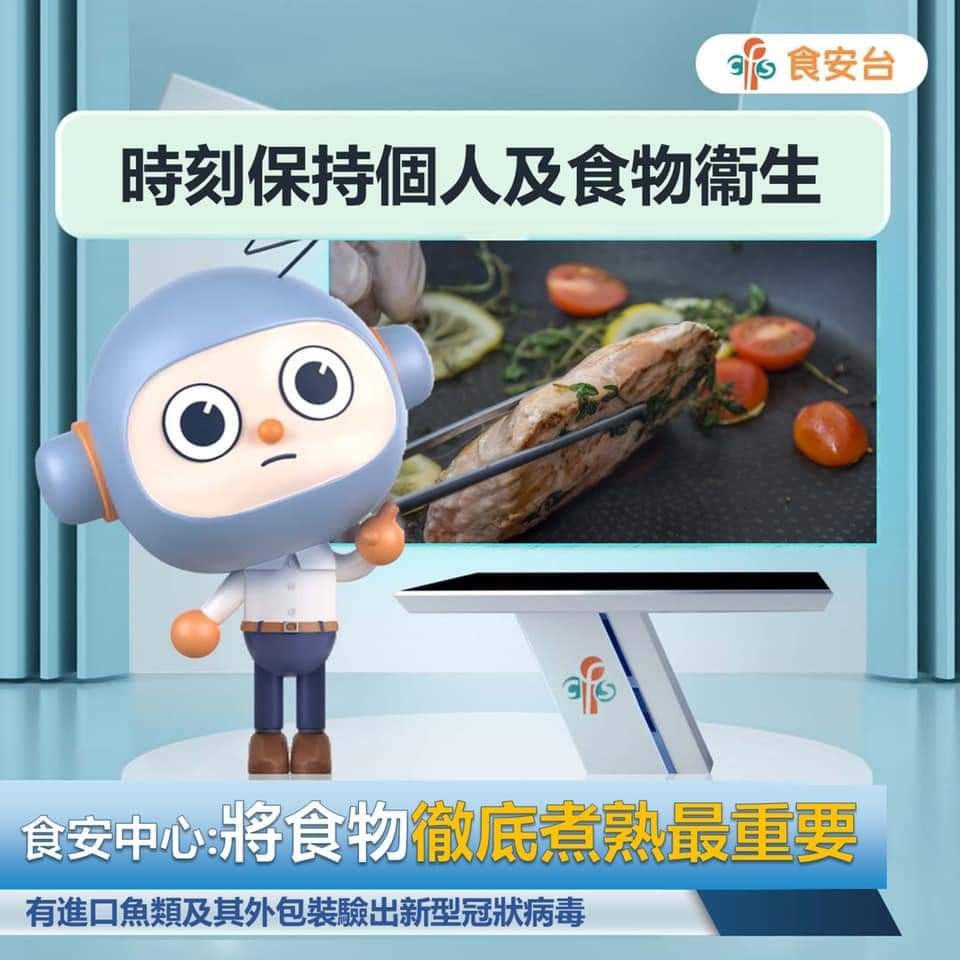
The CFS has stepped up precautionary testing measures to prevent the import of the COVID-19 virus through frozen foods. Up to now, over 14 000 samples of foods and their packaging have been collected for testing of the virus, with some samples of imported fish and their packaging tested with positive results. The fish stall involved had undergone deep cleansing and disinfection, and the market concerned was thoroughly cleansed.
The novel coronavirus is predominantly transmitted through droplets. The risk of acquiring the virus in our daily life through food packaging is very low, nor can the virus multiply in food or on food packaging. However, food or food packaging may be contaminated with the virus like any other objects or surfaces. Nonetheless, members of the public should not worry too much if they always observe personal, food and environmental hygiene, keep hands and utensils clean, and cook food thoroughly.
Contaminated hands play a significant role in facilitating indirect contact transmission by transferring the infectious virus from one surface to another and even into the human body. Viral transmissions are also likely to happen at high-touch points like door handles, handles of shopping trolleys and water taps. We should therefore wash hands frequently, especially before touching the eyes, the nose and the mouth, after returning home from grocery shopping, and after handling and storing purchased foods. In addition, food must be cooked thoroughly before consumption.
Cultured Meat
Cultured meat, also referred to as lab-grown meat and in vitro meat, etc., is recently a topic with increasing media coverage. It is produced by using animal cell culture technology and intended as an alternative to conventional meat products.
Production of Cultured Meat
To produce cultured meat, cells are first collected from target animals and allowed to proliferate in a culture medium under a controlled environment. During the process, a scaffold may be used as a supporting structure to provide an anchor for cell attachment and growth in order to produce products resembling meat muscle or other animal parts targeted to be produced.
When sufficient amounts of cells are formed, the cellular materials can be harvested from the growth medium. If a scaffold is used, it will be separated from the cultured meat. If the scaffold is edible, it can be left attached to the meat. The harvested cultured meat will then be used to produce the final product.
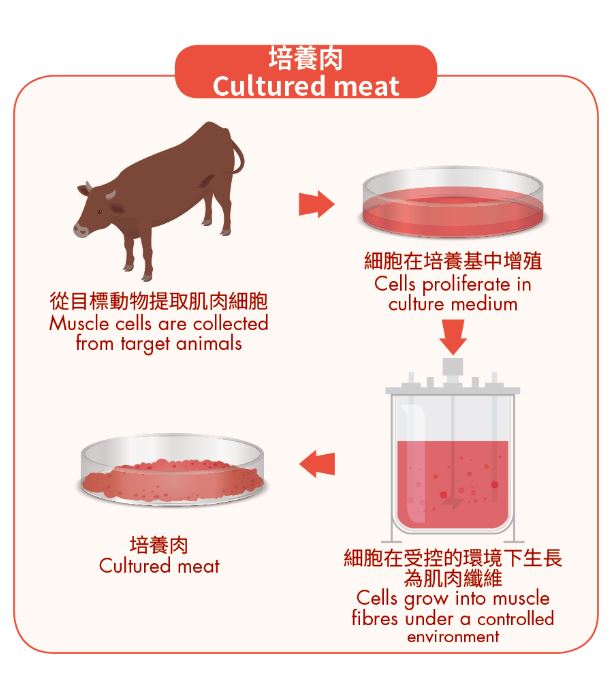
Production process of cultured meat (such as prepared by culturing muscle cells)
Safety Assessment of Cultured Meat
The production of cultured meat involves animal cell culture technology which is relatively new to food production and significantly different from the production of conventional meat products. The potential food safety risks of cultured meat to consumers are therefore a cause of concern.
Currently, countries or places such as Mainland China, the European Union, Australia, New Zealand, Canada and Singapore have taken different factors into account in their control of cultured meat and put in place assessment criteria for evaluating the food safety of cultured meat products prior to launch in the market.
In producing cultured meat for human consumption, it is the developers’ responsibility to ensure that their products are safe for human use. For safety assessment of cultured meat, the data requirements generally involve information on the production process and composition of cultured meat, allergenicity and toxicological and nutritional aspects, etc. The aspects to be evaluated in the safety assessment of cultured meat usually include:
- Characterisation of cultured meat
- Identity and purity (e.g. major components and impurities present)
- Structure
- Physical and chemical properties
- Production process
- Detailed description of the production process
- Information such as the source and preparation of cell lines, the culture media and scaffolding materials used, purity and genetic stability of the cell culture during the manufacturing process
- Compositional data
- Specifications
- Key chemical, physical and microbiological parameters
- Proposed uses and levels of consumption
- Target groups
- Consumption amount
- Estimate of exposure to undesirable substances
- Precautions and restrictions of use
- Any use in other countries/places
- Toxicokinetic information
- Absorption, distribution, metabolism and excretion
- Nutritional information
- Toxicological information
- Acute toxicity
- Chronic toxicity
- Carcinogenicity
- Genotoxicity
- Reproductive and developmental toxicity
- Allergenicity
- Analytical detection method
- Any safety assessment reports conducted by food safety authorities in other countries/places.
- Any other information to support product safety (e.g. digestibility assays for cultured meat).
Local Situation
Cultured meat products are not yet commercially available in Hong Kong. At present, cultured meat production technology is still costly. It requires research and development to further reduce the cost and make large-scale production of cultured meat more economically viable.
According to the Public Health and Municipal Services Ordinance (Cap. 132), all food for sale in Hong Kong should be wholesome and fit for human consumption. The Ordinance applies to all foods, including cultured meat. Developers of cultured meat should ensure that their cultured meat products are safe for human consumption.
Raw Freshwater Fish and Group B Streptococcus Infection
The Centre for Health Protection (CHP) recently reported an upsurge in local cases of Group B Streptococcus (GBS) infection when compared with previous years.
GBS are bacteria found in many animals, including mammals, amphibians, reptiles, fish, and in the guts of 20 to 40% of healthy adults as commensals. In most cases of GBS infection, the way of transmission is unclear, but mother-to-child transmission and improper handling and consumption of contaminated raw freshwater fish like big head, snakehead, etc. had been reported. GBS infection can cause severe invasive diseases including sepsis, septic arthritis, meningitis and infective endocarditis in vulnerable populations.
Freshwater fish intended for raw consumption had been prohibited for sale in Hong Kong for more than 30 years. For the sake of food safety, the public is advised to maintain good hand hygiene, dress hand wounds properly before handling raw food, keep raw and cooked foods separate and cook food thoroughly before consumption.
Fight against Antimicrobial Resistance in the Food Chain
The theme of the World Antimicrobial Awareness Week 2021 is 'Spread Awareness, Stop Resistance'. Susceptible populations including pregnant women, infants and young children, the elderly and people with weakened immunity (e.g. on antibiotic treatment or antacids) should avoid consuming raw or undercooked foods. Consuming raw or undercooked foods with no or inadequate heat treatment is more likely to contract 'superbugs'.
'Superbugs' are microorganisms that have developed antimicrobial resistance to stop a wide range of antimicrobial agents, such as antibiotics, from working against them. Whether or not 'superbugs' can cause illnesses, they may transfer their antibiotic resistance genes to other bacteria in our body and consequently reduce the effectiveness of antimicrobials.
To address antimicrobial resistance in the food chain, food should be cooked until the core temperature reaching 75°C, which can kill most bacteria including 'superbugs'. In addition, observance of the Five Keys to Food Safety, like maintaining good hand hygiene, can minimise cross-contamination of food by 'superbugs'. The trade can indicate the presence of raw or undercooked foods on the menus and provide a consumer advisory for consumers to make informed choices.
Watch Out for Cannabidiol Food Products That May Contain Prohibited Ingredients
Recently, the enforcement authority has identified some cannabidiol (CBD) products that contain tetrahydrocannabinol (THC). In Hong Kong, under the Dangerous Drugs Ordinance (Cap.134), cannabis and its component THC, regardless of the concentration, are dangerous drugs. Illicit import of cannabis or any products that contain controlled cannabinoids (such as THC) constitutes a criminal offence.
Cannabis plants contain numerous cannabinoids, and CBD is one of them. It should be noted that as CBD is generally extracted from cannabis, CBD products including food and beverage may contain a low level of THC. Products containing THC or other dangerous drugs at any concentration are regarded as dangerous drugs and are regulated under Dangerous Drugs Ordinance. We specifically remind the trade to avoid importing or producing related products lest they break the law.
(Remarks: The control of cannabidiol (CBD) as a dangerous drug under the Dangerous Drugs Ordinance (DDO) (Cap. 134) has come into effect since 1 February 2023).
Spot Check
Suspected Food Poisoning Case in a Japanese Restaurant Affecting Six Persons with Consumption of Raw Oysters
Many people love going to Japanese restaurants. However, we should be cautious in consuming high-risk foods such as sashimi, sushi and raw oysters to reduce the risk of food poisoning.
On 5 July 2021, the Centre for Health Protection of the Department of Health (DH) announced two suspected food poisoning cases in which six persons developed symptoms including abdominal pain, diarrhoea, fever and vomiting after consuming raw oysters during dinner in the same restaurant.
Oysters and other shellfish feed themselves by filtering microorganisms in seawater. They are easily contaminated with viruses (e.g. Hepatitis A and norovirus). Consumption of oysters that are undercooked and contaminated with viruses can cause infection and illnesses.
Assurance of food safety relies on tripartite collaboration among the Government, the food trade and the general public. Food traders have responsibilities to ensure that all foods for sale are fit for human consumption. To protect the food safety of customers, food handlers should stay vigilant. In preparing oysters (e.g. deep-fried oysters, braised oysters with ginger and scallions, braised oysters with port wine), they should be mindful of environmental hygiene and cleanliness of the utensils. They are also reminded to adopt the following hygiene practices:
- Buy oysters only from reliable suppliers. When inspecting incoming oysters, make sure that they are fresh and free of abnormal odours. Do not purchase and stop preparing the oysters if you are in doubt of their sources.
- Scald oysters in boiling water for at least 3 minutes after washing them thoroughly to eliminate viruses and harmful bacteria.
- Cook blanched oysters with other ingredients as soon as possible. In preparing deep-fried oysters, fry the batter-coated oysters in boiling oil until they turn golden yellow to ensure that the batter is thoroughly cooked. Leftover of batter made on the same day should be discarded.
- Keep hands clean. Wash hands thoroughly with soap and water before handling food and after visiting the toilet to prevent cross contamination of food and utensils.
- Food handlers with symptoms of vomiting or diarrhoea should not handle food.
Self-enhancement to improve customer satisfaction and alleviate worries of employers
1. Safe Kitchen
Introduction to “Safe Kitchen” Scheme
To facilitate trade members in adopting the Five Keys to Food Safety and good hygienic practices to enhance food safety in daily operation, the CFS has integrated the existing channels of risk communication to launch a new platform, namely “Safe Kitchen”, to communicate with the trade. The platform serves to provide food safety information of greater practical importance to meet the operational needs of catering outlets.
The “Safe Kitchen” platform disseminates up-to-date food safety information (including food safety guidelines and relevant legislative amendments) to the trade through a host of channels including WhatsApp, emails and dedicated websites. In response to food poisoning outbreaks in restaurants, the platform will also issue food alerts to remind the trade of the points to note in preventing future occurrences so that the risk of food poisoning can be minimised.
New dedicated websites and risk information exchange platforms will be rolled out under the “Safe Kitchen” Scheme. In addition, training materials tailor-made for the trade and different workshops for kitchen staff will be provided to enhance food safety and hygiene awareness among food handlers. Members of the trade are welcome to scan the following QR code to download the registration form for the “Safe Kitchen” Scheme in order to receive the latest food safety information in a timely manner.

2. Food Safety Day 2021 - Read and Check, Be Like Detective CFS!
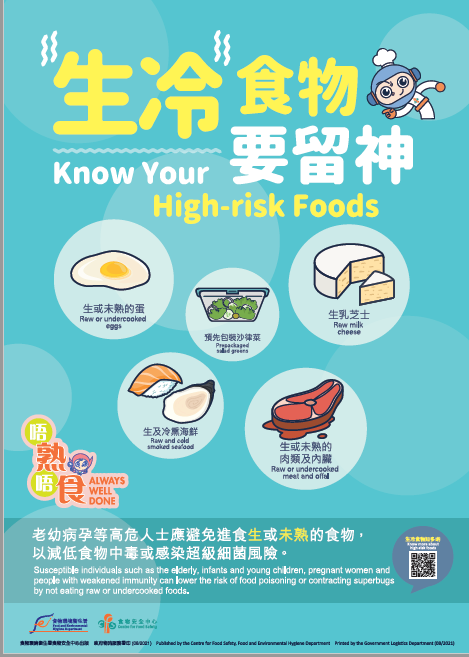
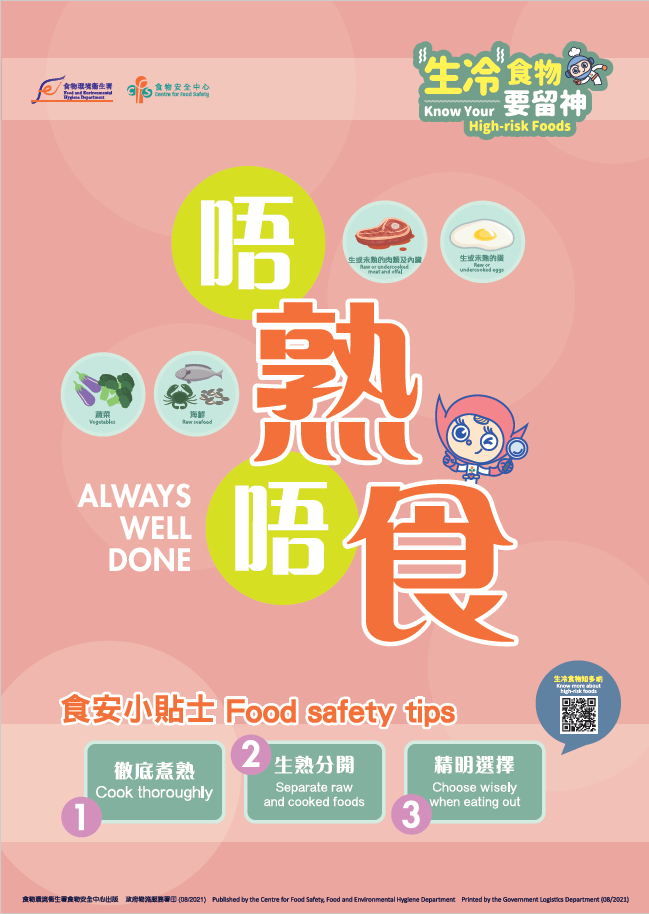
The theme of Food Safety Day 2021 is “Read and Check, Be Like Detective CFS!”. It aims at raising public awareness of the inherent risks of consumption of raw or undercooked food, especially among susceptible individuals.
To tie in with the theme of Food Safety Day 2021, the CFS organised a series of trade talks from July to November 2021, shedding light on topics including the safety issues of high-risk foods and the Five Keys to Food Safety to remind the trade what they can do to enable consumers to make informed dining choices with regard to raw or undercooked food.
The food safety trade talks of 2022 will be conducted in Cantonese. Admission is free of charge. Participants will receive a certificate of attendance after the talks. For details, please visit the website of Centre for Food Safety (www.cfs.gov.hk).
Food Safety Guidelines
3. Prepackaged Dried Mushroom and Date Samples in Breach of Food Labelling Legislation
On 28 June 2021, the CFS announced that a prepackaged dried mushroom sample and a prepackaged date sample were found to contain sulphur dioxide (a preservative allowed to be used in food) as a food additive but its functional class and name were not declared on the food label of the product, which constituted a breach of the Food and Drugs (Composition and Labelling) Regulations (Cap. 132W) (the Regulations). Under the Regulations, prepackaged food shall be legibly marked or labelled with a list of ingredients. In addition, the Regulations stipulate that for all prepackaged food for sale in Hong Kong containing sulphite in a concentration of 10 ppm or more, the functional class of the sulphite and its name shall be specified in the list of ingredients.
Please browse the following webpage for more details:
https://www.info.gov.hk/gia/general/202106/28/P2021062800873.htm
News on CFS
- Commencement of 7th Term Consumer Liaison Group
The 7th term (current term) Consumer Liaison Group (CLG) came into operation in July 2021. Due to the epidemic, certificates of membership were posted to the correspondence addresses of the current-term members in batches at the end of October 2021.
The aim of establishing the CLG is to provide a platform to strengthen communication with the public on various food safety issues and collect suggestions and comments from them. The CLG seeks to gain an understanding of public knowledge and beliefs in food safety and consumers’ perceptions of risks associated with food for developing effective risk communication messages to meet public needs.
People who are interested are welcome to join the CLG and work together in promoting food safety. The application form can be downloaded from the website listed below:
https://www.cfs.gov.hk/clg
For enquiries, please contact Mr AU YEUNG at 2381 6275.
- Food Safety Talk on Siu-mei
In July 2021, a number of food poisoning outbreaks involving a local siu-mei shop occurred in which the victims developed symptoms such as diarrhoea, vomiting and abdominal pain a few hours after consuming take-away siu-mei purchased from the shop. In view of the incidents, the CFS conducted a food safety talk on siu-mei specially for the food premises concerned to remind the staff to maintain personal and environmental hygiene during preparation and selling of siu-mei and follow good hygiene practices in handling siu-mei.
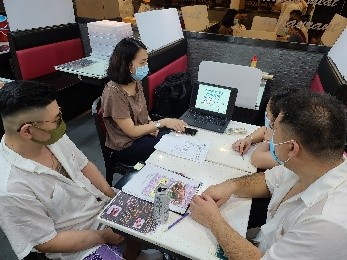
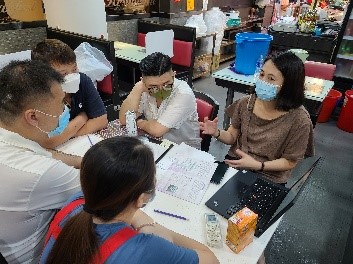
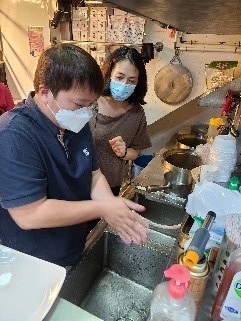
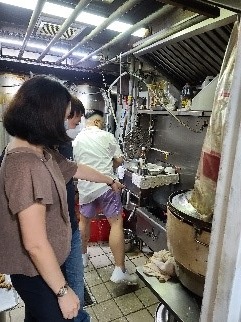
The CFS also provided posters for display at the food premises to remind siu-mei handlers to observe personal and food hygiene in minimising food contamination during preparation and selling of siu-mei so as to safeguard food safety.
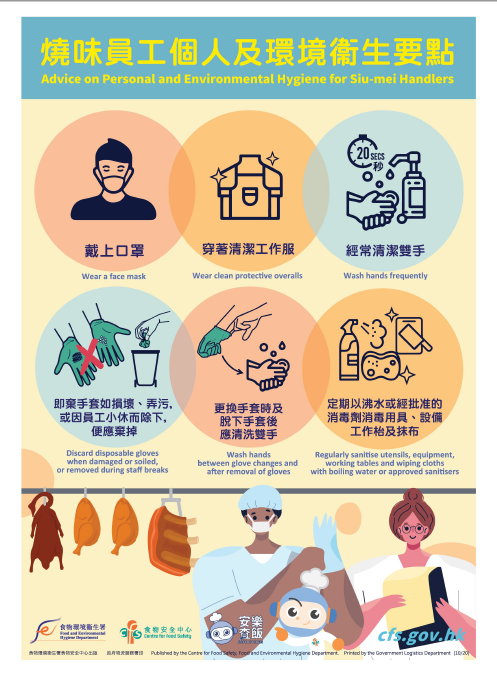
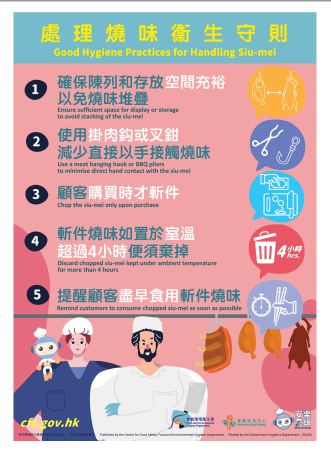
- Amended Provisions of Harmful Substances in Food Regulations to Come into Force
The Harmful Substances in Food (Amendment) Regulation 2021 (the Amendment Regulation) was passed by the Legislative Council to better safeguard public health. The Amendment Regulation specifies partially hydrogenated oils as a prohibited substance in food. The related amended provisions support the World Health Organization’s goal of eliminating industrially produced trans fatty acids from the global food supply by 2023 and are in line with one of the key measures under Towards 2025: Strategy and Action Plan to Prevent and Control Non-communicable Disease in Hong Kong. The relevant provisions will take effect on 1 December 2023.
The Amendment Regulation also strengthens regulatory control of mycotoxins in food and sets or updates the maximum levels for five other harmful substances, namely benzo[a]pyrene, glycidyl fatty acid esters, melamine, 3-monochloropropane-1,2-diol and erucic acid, in edible fats and oils, condiments or formula products intended for infants. The provisions stipulating the maximum levels of these harmful substances in food will all come into operation on 1 June 2023.
Apart from online publicity and a trade forum, the CFS has organised a series of technical meetings to assist the trade in understanding and complying with the Amendment Regulation. Please visit the following website for the latest information:
https://www.cfs.gov.hk/english/whatsnew/whatsnew_fstr/whatsnew_fstr_Food_Regulations_Harmful_Substances.html

- Hong Kong Brands and Products Expo 2021
The annual Hong Kong Brands and Products Expo will be held at Victoria Park from end of 2021 to early 2022. Same as previous years, the CFS will set up a booth during the Expo to promote food safety to the public. Publicity leaflets, pamphlets and souvenirs will be distributed. To approach food safety issues in a lively and interesting manner, the CFS staff will conduct on-stage interactive redemption games for the participants.
Having mentioned food safety, we must pay attention to the safety of consuming seasonal foods such as hotpots, “Poon Choi” and hairy crabs, which would probably appeal to you on autumn and winter days. In fact, autumn and winter are the peak seasons of viral gastroenteritis caused by norovirus. To minimise the risk of foodborne diseases, you are reminded to observe the following Five Keys to Food Safety:
- Choose (choose safe raw materials);
- Clean (keep hands and utensils clean);
- Separate (separate raw and cooked food);
- Cook (cook thoroughly); and
- Safe temperature (keep food at safe temperatures).
The CFS will share more food safety information with the public at the coming Expo. You are welcome to join us and learn more about food safety.
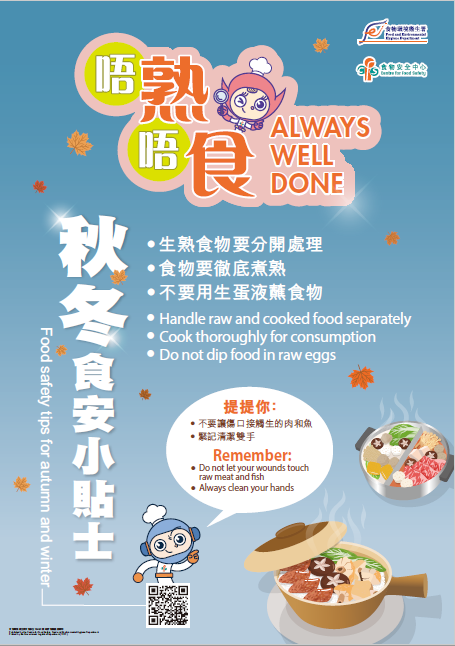
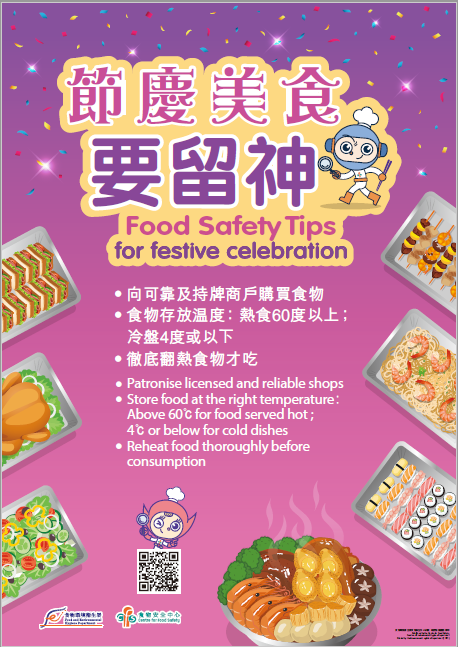
Ask Our Mascots

Wash the Husk of Longans. Do Not Peel Them with Teeth.
| Uncle CHU: | MUI, I've bought several catties of longans in the market. They are big, fresh and attractive in appearance. I'd taste some of them now. Hmm, it's yummy! |
| MUI: | Wait a minute, Uncle CHU! The longans have not been washed. You just peeled them with your teeth. That's scary! |
| Uncle CHU: | What's scary about it? |
| MUI: | After harvesting longans, farmers or food manufacturers may add sulphur dioxide, that is SO₂, to longans to prolong their shelf life. SO₂ is a preservative used in a variety of foods. It is not uncommon to treat longans with SO₂. However, some people may be allergic to the chemical. They will develop symptoms such as shortness of breath, headache or nausea after exposure to it. It's just not appropriate that you peeled longans with your teeth. |
| Uncle CHU: | How can I reduce the intake of SO₂ from consumption of longans? |
| MUI: | Don't worry too much! SO₂ is soluble in water. You can remove a large portion of SO₂ from the fruit surface by washing longans thoroughly and rubbing them gently under running water. One more thing. Do not bite the husk of longans. Instead, remove the husk with clean hands before eating the fruit! |
| Uncle CHU: | That's simple. Now let’s wash the longans and our hands and share the fruit together. |
| MUI: | Sure! |
Knowledge Improvement Quiz
-
During non-crisis times, we should make sure that the refrigerator is at ____°C or below and the freezer compartment at -18°C or below. (See “Feature Article”.)
- _________ is a scientific and systematic approach to identify, assess and control hazards in the food production process (from purchasing, receiving, transportation, storage, preparation, handling, cooking to serving). (See “Mascot ON in Lesson”.)
- Frozen confections not properly handled during production and retailing are exposed to a high risk of contamination by microorganisms such as Listeria monocytogenes or _______________. (See “Diary of Mascot ON”.)
Answers:
- 4
- The Hazard Analysis and Critical Control Point (HACCP) System
- coliform bacteria
Diary of Mascot ON
CFS Theatre - Soft Ice-creeeeeeam
It is cool to have a cup of soft ice-cream on a hot day. However, we must pay special attention to the production and selling of frozen confections. If we do not do so, there will be a high risk of food contamination by microorganisms such as coliform bacteria or Listeria monocytogenes.
In making soft ice-cream, the ice-cream pre-mix has to undergo heat treatment (commonly pasteurisation) to minimise microbiological hazards. The heat-treated mixture should be stored at a low temperature as soon as possible to prevent microbial growth. Nevertheless, contamination by microorganisms may still occur during handling and selling of soft ice-cream under the following circumstances:
! Improper storage temperature;
! Poor hygiene of soft ice-cream dispensing machines;
! Poor personal hygiene of dispensing machine operators.
To prevent the above, food premises supplying soft ice-cream should follow the Food Safety Advice for Manufacture and Sale of Frozen Confections:
🍦 Check the temperature of soft ice-cream dispensing machines regularly;
🍦 Arrange regular inspection, maintenance and repairs of soft ice-cream dispensing machines;
🍦 Provide regular training for staff members on operation of equipment (e.g. cleaning of soft ice-cream dispensing machines and food hygiene).
If you like soft ice-cream, remember to patronise reliable vendors and finish your ice-cream as soon as possible.